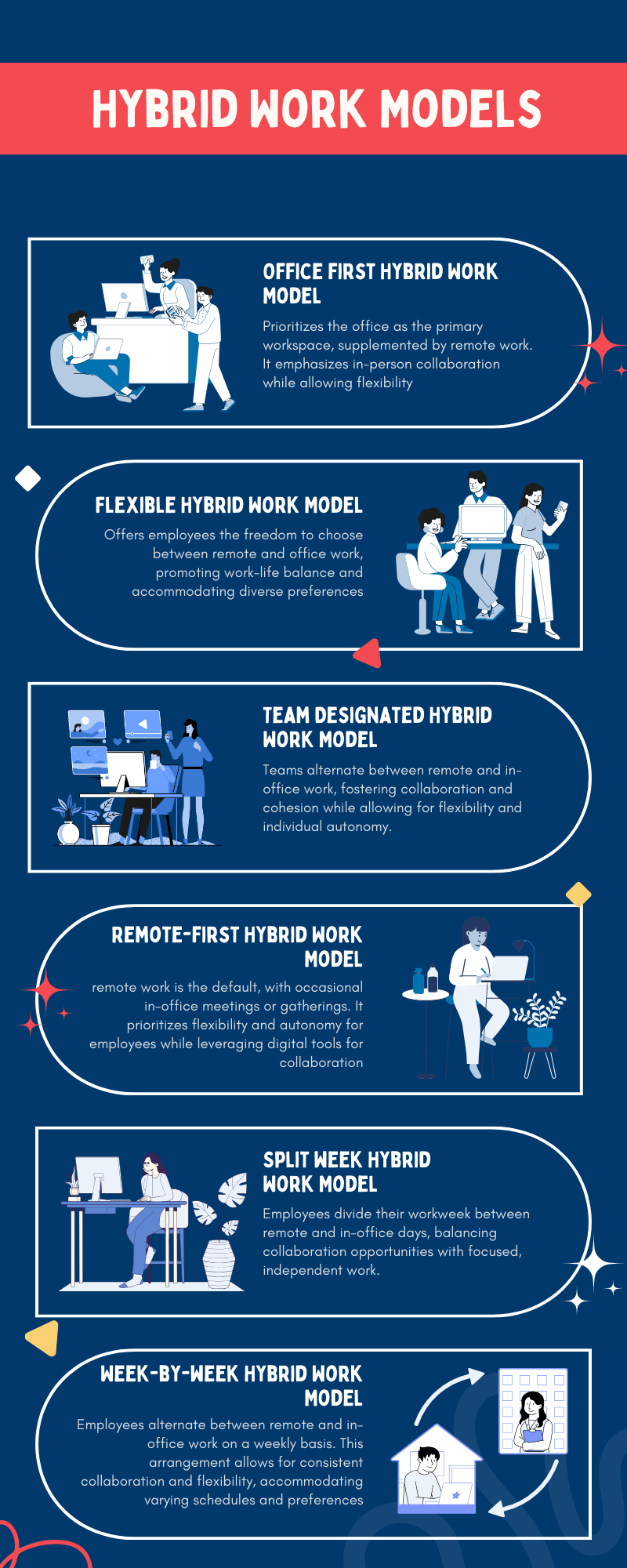In recent years, there has been a significant shift in workspaces, reshaping how organizations approach work globally. The traditional concept of fixed office spaces has evolved into the emerging trend of hybrid work, blending in-office, remote, and mobile workstyles.
This transformation gained momentum with the beginning of the global COVID-19 pandemic in early 2020, profoundly changing perspectives on work and workplace dynamics.
Today, individuals seek and expect a balance between the flexibility of remote work and the collaborative atmosphere cultivated by office environments.
Creating a hybrid workforce includes the advantages of location-flexible work through tailored policies, streamlined processes, and innovative technology. While offices remain pivotal hubs for facilitating meetings, collaboration, and team cohesion, striking a balance is key.
Today, in this guide, we will explore the hybrid work model, and its several types, exploring its significance, benefits, and limitations.
Furthermore, we will offer actionable insights to help you understand how a seamless hybrid work environment drives your organization forward.
Table of Contents
ToggleWhat is a Hybrid Workplace?
Hybrid work is a versatile work approach that integrates in-office, remote, and mobile workers seamlessly. This flexible model empowers employees to work in environments that suit their productivity best. Many organizations adopt hybrid workspaces, known as virtual workspaces, to facilitate collaboration and improve communication among teams.
In the hybrid work landscape, employees have the flexibility to transition between different workspaces, adapting to the demands of their tasks. This adaptable model varies based on organizational structure and the nature of the work at hand.
Now, as businesses navigate this changing landscape, coworking spaces emerge, providing the desired customer experience for contemporary workers. With 70% of businesses considering a hybrid work strategy, the demand is clear.
However, as hybrid working is still evolving, many businesses are uncertain about its dynamics.
What Role Does Coworking Play in a Hybrid Workplace?
Today, Hybrid working has surfaced as a dynamic approach, blending the freedom of remote work with the reliability of office-based routines. Coworking allows social connections, countering the isolation remote workers may face, and boosts creativity by facilitating idea exchange.
Moreover, it presents a budget-friendly option compared to traditional office setups, cutting down on expenses like rent and utilities.
In the hybrid work model, employees balance their time between home and coworking spaces or offices, as per their needs. Coworking spaces, a key component of this trend, are gaining traction across different industries.
These collaborative hubs provide a professional atmosphere that sparks creativity and facilitates innovation while cultivating a strong sense of community.
They serve as ideal settings for startups, small businesses, and remote workers seeking interaction, networking, and idea exchange. Adopting flexibility and work-life harmony, coworking spaces seamlessly integrating into the hybrid work landscape, improving productivity and collaboration.
What is the Difference Between Remote and Hybrid Work?
While both remote work and hybrid work enable working from home, they differ in terms of flexibility, employee dynamics, and commuting arrangements.
Remote work offers the flexibility of working from anywhere without the need for a physical office, facilitated by technology. On the other hand, hybrid work incorporates both office-based and remote employees, accommodating a mix of in-person and virtual collaboration.
The key distinction lies in the level of flexibility: remote work provides more freedom to employees, while hybrid work fosters real-world interactions among colleagues.
Remote work can have drawbacks, particularly in its potential to diminish the vital aspects of human connection, collaboration, and community-building, which traditional office environments excel in facilitating.
When opting for remote work, the distinction between hybrid and fully remote organizations becomes significant. Understanding these differences is crucial for individuals navigating their preferences in remote work settings.
Exploring the hybrid work-from-home model, you might discover it does not offer all the advantages of fully remote work and may have its limitations. Alternately, joining a fully remote company grants greater freedom, flexibility, and social engagement.
The decision rests with you. Consider all aspects of the equation and prioritize what aligns best with your needs and preferences.
Types of Hybrid Work Models
As every business is unique, hybrid working models will vary to suit the specific characteristics of your organization, including the nature of your work, industry, and customer base. While the type of hybrid work model an organization adopts can vary significantly based on these factors, certain models are more common than others.

The following are some of the most common types of hybrid work models:
1) Office First Hybrid Work Model
Among the different hybrid work models, an office-first approach takes back to the traditional pre-pandemic work setup. In this model, employees primarily work from the office, with the option to work remotely (typically from home) for a portion of their time.
Generally, employees are permitted to work remotely for one or two days each week or a few days per month.
Some organizations offer flexibility in the allocation of these remote days, allowing employees to use them as needed.
Alternatively, certain corporations determine offsite workdays based on specific instances, considering factors such as office attendance requirements and scheduling needs.
Pros:
- Increased levels of cooperation and coordination across departments.
- Improved communication efficiency.
- More creativity and motivation from face-to-face interactions.
- Improved employee sociability.
- Physical connection to the culture and community of the workplace.
Cons:
- Not necessary for self-managed and low-collaboration roles.
- Increased commuting expenses and duration.
- Employee dissatisfaction arises when they request workplace flexibility but are not granted it.
2) Flexible Hybrid Work Model
Introducing the next model, which is our Flexible Hybrid Work Model! Unlike traditional office setups, here, employees decide when to work from the comfort of their home or join us in the office for some collaborative vibes, maybe even on our special Mondays or Tuesdays.
This provides happiness and comfort by giving you the freedom to choose your workspace. Plus, the hot-desking setup ensures flexibility – no assigned seats, just grab any available spot and make it yours!
You can implement this model in your company and create a work environment where flexibility and cheerfulness grow.
Pros:
- Improved authority and trust among employees.
- Improved morale and well-being among employees.
- Improved interest from job seekers and recruitment.
- Lower travel expenses (both financial and temporal).
- Increased levels of involvement among employees.
Cons:
- Reduced output or missing objectives.
- Office space underutilization.
- An increase in silos within teams.
3) Team Designated Hybrid Work Model
Introducing the next tailored team-based hybrid work model! In this model, leadership crafts personalized flexibility plans for each team. Whether you want to be in the office or prefer the comfort of your home, there are options for you.
From fully remote to a mix of office and home days, you can find what works best to achieve your company and team goals together!
This designated team’s hybrid work model is a productivity powerhouse! By strategically assigning teams to work either in the office or remotely, you can optimize efficiency and boost employee productivity to new heights.
In this hybrid work environment, companies assign teams to work from home or on-site. Organizations that require certain employees to work from the office profit from such a working setup.
Pros:
- Improved productivity and efficiency in communication.
- Lower labor and commute costs.
- Possibilities for self-management for managers and employees.
- Improved acceptance of different working techniques.
Cons:
- Disconnect between personnel who work in person and those who work remotely.
- Growing divisions among teams necessitate deliberate communication from upper management.
4) Remote First Hybrid Work Model
In a remote-first hybrid work model, the spotlight is on remote work as the main role. But don’t worry, you have occasional in-person meetups covered for those team huddles, client gatherings, or just a change of scenery.
It is all about adopting the remote revolution while keeping the door open for those who desire some office time.
Communication? Here you get all the tools and solutions to keep everyone connected and informed, no matter where they are.
You can use this model for your business, where remote rules are supreme, but the office is always there for those who want it.
Pros:
- Enhanced trust between employers and employees.
- Lower overhead expenses.
- Improved wellbeing and flexibility in work-life.
- Simplified expectations and benefits for employees.
- Improved interest from job seekers and employee recruiting.
Cons:
- Maintaining distant worker engagement is more difficult.
- Decreased communication within and between teams.
- An increase in silos and miscommunication.
- Increased rates of employee fatigue and resignation.
5) Split Week Hybrid Work Model
Let us now explore the split-week hybrid work model! This innovative approach involves gathering insights from employees about their workplace preferences, allowing managers to assign both on-site and remote workdays for each team. It’s all about ensuring everyone feels valued and heard.
With this model, you’ll notice a less crowded workspace, giving employees the flexibility to organize their schedules more efficiently.
However, it’s essential to be mindful of potential increased costs associated with this strategy, such as higher power bills and remote office maintenance expenses. Nonetheless, by investing in your team’s well-being, the benefits can far outweigh the costs.
Pros:
- Prevents crowded areas and vacant offices.
- Makes room for experimentation and open communication.
- Enhanced opportunities for feedback and communication.
- Greater flexibility in unpredictable situations.
Cons:
- A rise in overhead and operational expenses.
- Some teams might never work together in the same space.
- Demands uniformity among teams.
- An increase in the time and cost of commuting.
6) Week by Week Hybrid Work Model
Let us delve into the final segment of the hybrid work model! In this model, leaders take the command, determining when employees should be in-person and when they can work remotely.
It is all about striking the perfect balance between office collaboration and remote flexibility.
With this approach, you will always have a presence in the office, even if it is just a few teams at a time. Now, imagine this, one week, select team members hold down and come, while the next, it is another group’s turn to come to office.
This setup works outstanding for organizations with a large workforce, allowing for optimal space utilization and reduced administrative costs.
Pros:
- Lower overhead and transportation expenses.
- Capacity to reduce the size of the office space.
- Beneficial for large businesses.
- Enhanced predictability and future planning.
- Consistent team meetings and goal setting.
Cons:
- The in-person weeks might not be beneficial for self-managed roles.
- Silos inside and between teams.
- Not useful for unanticipated gatherings or events.
Advantages of the Hybrid Work Model
Now let us dive into the benefits of adopting a hybrid workplace strategy! This approach brings benefits for both employees and employers alike. Here are the benefits it offers:
1) Seamless Collaboration Anywhere with Minimal Effort
The COVID-19 pandemic taught us a practical lesson: with the right support and tools, productivity can grow whether we are working from home or in the office.
And guess what? Collaboration knows no bounds when we are provided with the right technology to stay connected, no matter where we are.
Adopting a permanent hybrid work model was a smooth transition for many organizations.
Why? Because it required no implementation effort. It’s all about building on what works and adapting to the evolving needs of the modern workforce!
2) Talent Acquisition and Engagement
Driving growth and success without employees is not possible. Nowadays, the workforce is pushing back against traditional on-site work arrangements.
Increased employees, especially top-tier talent, are seeking out hybrid work options and flexible schedules to achieve a better work-life balance. Adopting hybrid work is not about meeting employee demands; it’s also a strategic move for companies.
By offering flexibility, organizations can attract, retain, and motivate top talent.
3) Overall Cost Savings
Discover the incredible savings potential of hybrid work – up to a stunning 40% reduction in office space costs.
With a well-crafted hybrid workplace strategy and the right technology in place, you can not only save big bucks but also transform the workplace experience for your employees. Imagine the possibilities!
From cutting office space and furniture expenses to cutting down utility bills, the savings are real. But wait, there is more – say goodbye to pricey lunches and coffee runs.
So, it is time to revolutionize your workplace and your bottom line with the power of hybrid work!
4) More Flexibility = Productivity
When it comes to productivity, it is not about where you clock in or how long you stay – it is all about the results you deliver during your work hours.
Instead of micromanaging time, focusing on empowering employees to achieve their goals, and providing the support they need is key to driving productivity.
Research also shows that when given the flexibility to work outside traditional office hours, employees often find their peak productivity times. It is not about working more hours but rather optimizing time management for peak performance.
5) Improved Employee Happiness and Health
Flexibility is the new name of the game, and employees are raising the bar for it. Hybrid work opens doors to a world of possibilities, providing employees with the precious gift of time and energy.
With more flexibility, they can prioritize self-care, from fitting in workouts to making healthier food choices and attending medical appointments without stress.
And let us not forget about family – hybrid work allows for better caregiving and quality time with loved ones. These wave-effects on mental health and job satisfaction are profound, benefiting both individuals and employers alike.
By investing in employee well-being, organizations can also streamline their healthcare investments and maintain retention rates and loyalty.
6) Future Proofing Your Workspace
Adopting a hybrid work model signals your organization’s forward-thinking approach and adaptability to more comprehensive demographic shifts.
In today’s landscape, top-tier talent has the freedom to choose where they work, and companies that prioritize hybrid work are assured of success in the face of future workforce changes.
By finding the ideal balance between in-office and remote work, organizations can easily adjust to evolving needs, whether that means ramping up remote options or increasing in-office presence.
It is all about staying ahead of the curve and creating a hybrid workplace that is ready for whatever the future holds.
What are the Challenges of a Hybrid Working Model?
Unlocking the full potential of hybrid and remote work is a significant change, but it all depends on having the right support system in place. Let’s take a closer look at some of the key challenges you might encounter along the way to a hybrid working model:
1) Communication
Hybrid work comes with its fair share of challenges, and technology is not the only limitation we face. Communication can be tricky in remote and hybrid teams.
Beyond the technical aspects, there is the added complexity of different communication styles. Some folks succeed with the virtual settings, while others may struggle to find their voice.
And let’s not forget about the various dynamics at play – from power dynamics to language barriers – all of which can further complicate communication in the workplace.
2) Coordination
When teams are divided between remote and in-office settings, it is easy for remote teammates to feel left out of the loop.
Simple exchanges and minor decisions can often happen organically among those physically present, inadvertently excluding remote members.
This pattern can grow over time, leading to remote team members missing larger discussions and crucial decisions.
So it is essential to bridge this communication gap to ensure everyone feels included and valued in the decision-making process.
3) Engagement
We have often overlooked the power of being physically present with our coworkers. Being in the same space nurtures a sense of unity and reminds us that we’re all in this together.
Without that connection, it is easy to feel disconnected and less engaged. As a leader, it can be challenging to inspire and uplift your team when you’re not fully aware of the factors influencing their morale.
4) Too Many Silos
When we are not in the same physical space, teams and individuals can unintentionally become isolated. This lack of communication often leads to duplicated efforts and vital knowledge being overlooked.
To address this, we need a cultural shift—one that celebrates knowledge sharing and recognizes those who do so generously. By making it easier for people to collaborate across team lines, we remove barriers and cultivate a more interconnected work environment.
5) Culture
As we see new faces entering the organization, there is a growing need to smoothly integrate these individuals into your company culture.
Whether they’re interns, fresh recruits, or experienced executives, the challenge remains the same. So, it is crucial to prioritize socialization and cultural integration to ensure a cohesive and vibrant workplace environment.
6) Security Concerns
As more employees work remotely, new vulnerabilities and risks emerge. These risks can escalate when employees resort to unauthorized software for file sharing or communication due to frustration with outdated systems.
Additionally, managing IT support from a distance adds complexity, prompting individuals to seek solutions to technical issues. It is essential to address these challenges proactively to safeguard data and streamline support processes.
Some Key Takeaways:
- Although several businesses had hybrid offices before COVID-19, the pandemic forced more employers to reconsider the conventional always-on-site work strategy following months of mostly productive work from home.
- Employers must re-organize workspaces to be optimal for a reduced but variable number of on-site workers to transition to a hybrid model.
- Employees can have more freedom to work in a setting that best suits them in a hybrid workplace, where their performance is assessed on outcomes rather than punctuality.
- Supervisors need to exercise caution to prevent setting up a two-tiered system that gives remote workers less value than those who work in offices.
Conclusion
Hybrid work isn’t exactly a new concept, but its rise has been nothing short of remarkable in recent years. With the global lockdowns, businesses that never considered hybrid setups had to adapt, making it the new norm.
Despite its rapid growth, hybrid work is not as discouraging as it seems. It is simply about giving employees the freedom to work from various locations, boosting productivity and overall satisfaction.
To succeed in a hybrid model, both individuals and businesses need to incorporate qualities like organization, transparency, empathy, and adaptability.
This cultivates a healthy work environment that welcomes flexibility in time, tasks, and locations, benefiting everyone involved, from the organization to the broader community.
By now, you must have learned the importance of hybrid work models and weighed their pros and cons. With this insight, you are better prepared to choose the model that fits your needs and boosts productivity for both you and your team.
When implemented effectively, hybrid work is a tried-and-true model that has stood the test of time across industries worldwide.
It is a formula for success that encourages satisfaction and efficiency, ensuring a harmonious balance for all involved.
FAQs (Frequently Asked Questions)
1) What is a Hybrid Schedule for Work and is it worthwhile?
Hybrid work schedules blend remote and on-site work, providing an official structure for employees’ time.
There are four primary types: cohort, staggered, manager-set, and employee-designed schedules. Each organization has its guidelines regarding office commutes for hybrid team members.
Like any work arrangement, hybrid schedules come with their difficulties. However, with clear expectations, effective communication, and established protocols, the transition to hybrid work can be smooth and stress-free.
And let’s not forget the benefit: hybrid work has a reputation for boosting productivity.
2) What is the Weekly Workday Count for Hybrid work?
The number of days per week hybrid workers are expected to be in the office varies based on the employer’s internal structure and their specific hybrid work policies.
Some companies offer flexibility in the number of hours worked each day if deadlines are met. However, in other organizations, working hours are closely monitored and adhered to within the hybrid work setup.
3) What makes a Successful Hybrid Workplace?
To succeed in a hybrid workplace, it is crucial to invest in technology that facilitates seamless collaboration, both in-person and virtually. Clear hybrid policies set by managers lay the foundation for success.
Providing remote workers with the right tools, from hardware to software and infrastructure, empowers them to actively engage in team endeavors.
By establishing transparent expectations for both on-site and remote employees, everyone stays aligned on working hours, availability, response times, and project deliverables.
4) Does hybrid work have a higher level of stress?
The stress dynamics of hybrid work depend on numerous factors, such as individual work styles, organizational culture and policies, and the nature of the tasks at hand.
The trend is clear: many have warmly welcomed the chance to work remotely for part of the week.
The idea of reverting to a rigid 9-to-5 office routine does not sit well with most. Having greater freedom over one’s day brings a sense of fulfillment.
Research backs this up, revealing that hybrid work significantly enhances work-life balance, lowers the risk of burnout, and cuts work-related stress by as much as 50%.
Moreover, Stress and burnout often arise from prolonged job-related pressures, influenced by several factors like resource scarcity, interpersonal conflicts, ineffective management, and heavy workloads.
However, hybrid work has emerged as a big relief for many, granting them the freedom to work on their terms.
This flexibility promotes peace of mind and empowers individuals to choose when and where they work.
To address concerns about hybrid workers feeling disconnected from their company and colleagues, employers can implement solutions to encourage connection and collaboration, ensuring that everyone remains engaged and supported.








